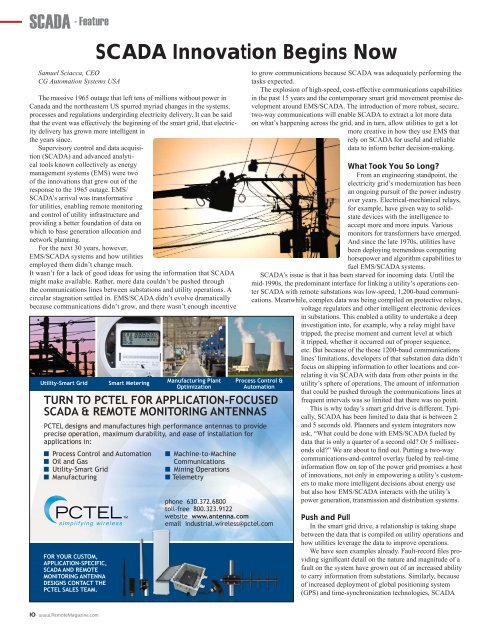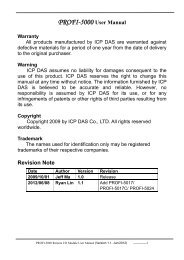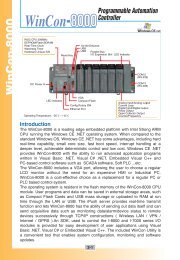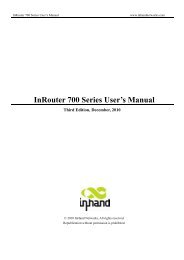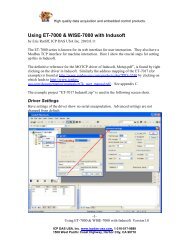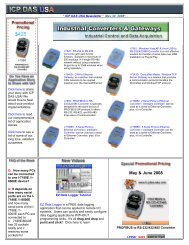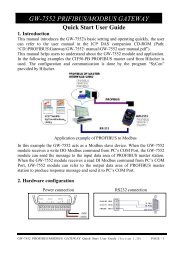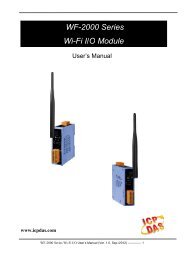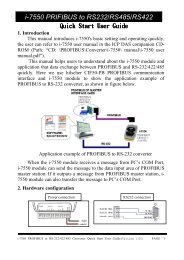Contents - ICP DAS USA
Contents - ICP DAS USA
Contents - ICP DAS USA
You also want an ePaper? Increase the reach of your titles
YUMPU automatically turns print PDFs into web optimized ePapers that Google loves.
SCADA - FeatureSamuel Sciacca, CEOCG Automation Systems <strong>USA</strong>The massive 1965 outage that left tens of millions without power inCanada and the northeastern US spurred myriad changes in the systems,processes and regulations undergirding electricity delivery. It can be saidthat the event was effectively the beginning of the smart grid, that electricitydelivery has grown more intelligent inthe years since.Supervisory control and data acquisition(SCADA) and advanced analyticaltools known collectively as energymanagement systems (EMS) were twoof the innovations that grew out of theresponse to the 1965 outage. EMS/SCADA’s arrival was transformativefor utilities, enabling remote monitoringand control of utility infrastructure andproviding a better foundation of data onwhich to base generation allocation andnetwork planning.For the next 30 years, however,EMS/SCADA systems and how utilitiesemployed them didn’t change much.It wasn’t for a lack of good ideas for using the information that SCADAmight make available. Rather, more data couldn’t be pushed throughthe communications lines between substations and utility operations. Acircular stagnation settled in. EMS/SCADA didn’t evolve dramaticallybecause communications didn’t grow, and there wasn’t enough incentiveSCADA Innovation Begins Nowto grow communications because SCADA was adequately performing thetasks expected.The explosion of high-speed, cost-effective communications capabilitiesin the past 15 years and the contemporary smart grid movement promise developmentaround EMS/SCADA. The introduction of more robust, secure,two-way communications will enable SCADA to extract a lot more dataon what’s happening across the grid, and in turn, allow utilities to get a lotmore creative in how they use EMS thatrely on SCADA for useful and reliabledata to inform better decision-making. What Took You So Long?From an engineering standpoint, theelectricity grid’s modernization has beenan ongoing pursuit of the power industryover years. Electrical-mechanical relays,for example, have given way to solidstatedevices with the intelligence toaccept more and more inputs. Variousmonitors for transformers have emerged.And since the late 1970s, utilities havebeen deploying tremendous computinghorsepower and algorithm capabilities tofuel EMS/SCADA systems.SCADA’s issue is that it has been starved for incoming data. Until themid-1990s, the predominant interface for linking a utility’s operations centerSCADA with remote substations was low-speed, 1,200-baud communications.Meanwhile, complex data was being compiled on protective relays,voltage regulators and other intelligent electronic devicesin substations. This enabled a utility to undertake a deepinvestigation into, for example, why a relay might havetripped, the precise moment and current level at whichit tripped, whether it occurred out of proper sequence,etc. But because of the those 1200-baud communicationslines’ limitations, developers of that substation data didn’tfocus on shipping information to other locations and correlatingit via SCADA with data from other points in theutility’s sphere of operations. The amount of informationthat could be pushed through the communications lines atfrequent intervals was so limited that there was no point.This is why today’s smart grid drive is different. Typically,SCADA has been limited to data that is between 2and 5 seconds old. Planners and system integrators nowask, “What could be done with EMS/SCADA fueled bydata that is only a quarter of a second old? Or 5 millisecondsold?” We are about to find out. Putting a two-waycommunications-and-control overlay fueled by real-timeinformation flow on top of the power grid promises a hostof innovations, not only in empowering a utility’s customersto make more intelligent decisions about energy usebut also how EMS/SCADA interacts with the utility’spower generation, transmission and distribution systems.Push and PullIn the smart grid drive, a relationship is taking shapebetween the data that is compiled on utility operations andhow utilities leverage the data to improve operations.We have seen examples already. Fault-record files providingsignificant detail on the nature and magnitude of afault on the system have grown out of an increased abilityto carry information from substations. Similarly, becauseof increased deployment of global positioning system(GPS) and time-synchronization technologies, SCADA10 www.RemoteMagazine.com


